Tom Rosen is a retired TWA Captain, a former ABS board member. He flies a Bonanza.
TOM ROSEN'S STORY: "An extraordinary journey of discovery began for me just over five years ago in Truckee, California. Our annual gathering of retired Trans World Airlines (TWA) pilots and our wives that year happened to be at Truckee (KTRK), just north of Lake Tahoe in the Sierra Nevada Mountains. Four couples had rented a beautiful 5,000sqft mountain home while the others were staying in their motor homes at a local campground. A few of us had flown our planes while the others had driven. It was typical summer weather in the California mountains, sunny days and cool clear nights. We all had known each other for over forty years and we had a really good time being together again. Little did we know that we would be returning to our homes in a few days ... minus two pilots.
"One pilot had arrived a few days earlier in his beautiful RV-8 painted in TWA colors. He had owned it for several years and flew it several times a week. A great pilot who learned to fly as a teenager in the South, he built his time as a crop-duster flying Stearmans, before hiring on at TWA in the mid-1960's. I first met him when we were new-hires based in Newark, NJ flying the Boeing 727. He put in over 30 years with the airline, with most of the last ten as a check Captain, before retiring early to enjoy the good life. He lured me to Patagonia for some of the world's most pristine fly fishing on the Baker River. He was a great pilot and a wonderful friend.
"The other TWA Captain and his wife had driven a motor home from their airport home in Eastern Washington State. He owned several planes that he kept in his attached hanger. He also learned to fly as a teenager in SoCal and built his time as a CFI. He hired on at TWA a couple of years before his pal and I did, and I first met him when we used to fly together with me in the right seat. He also retired early, and spent a few memorable years as the Captain on a private jet owned by a Saudi prince. Oh! The private jet was a L-1011. He had some very interesting stories to tell.
"After retiring to Washington, he used to entertain himself doing acrobatics in his Christen Eagle or flying his Citabria into the wilderness strips located in the mountains of Idaho. I flew with him several times and he was one of those pilots who strapped the airplane to himself, rather than the other way around. He flew it like it was part of him.
"They departed Truckee mid-morning for a few hours of flying and a couple of $100 hamburgers somewhere in Nevada. They were due back early afternoon.
"They never returned.... The RV-8 stalled and crashed turning onto final approach returning to Truckee.
"As I began to recover from my shock, I 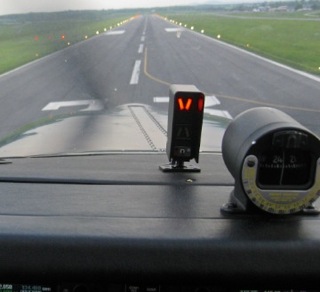 reached out to a few Beech owners I know well. One call was to Fred Scott in Virginia who had also lost two friends in a nearly-identical Bonanza 36TC stall/spin accident in the base-final turn to his farm runway. He had been operating his own Beechcraft from that same runway -- sloping, curved, grass, 3000ft. with an obstacle -- for decades and he asked me if my TWA pals had a Angle of Attack sensor/display. They didn't, and I asked him why he had posed the question. Fred explained that he had used an AOA in his Bonanza 36 for 20+ years; he explained how well a simple AOA device had worked in his own light aircraft and why it added valuable information. He suggested that a simple inexpensive AOA display might have prevented both crashes. I, a career TWA pilot, was familiar with AOA as a sensor for our complex FMS systems (and as raw data in GoAround/GustEscape mode)...but I readily admit that I was unaware that AOA was available to the light aircraft general aviation fleet. And so began my journey of discovery about AOA. reached out to a few Beech owners I know well. One call was to Fred Scott in Virginia who had also lost two friends in a nearly-identical Bonanza 36TC stall/spin accident in the base-final turn to his farm runway. He had been operating his own Beechcraft from that same runway -- sloping, curved, grass, 3000ft. with an obstacle -- for decades and he asked me if my TWA pals had a Angle of Attack sensor/display. They didn't, and I asked him why he had posed the question. Fred explained that he had used an AOA in his Bonanza 36 for 20+ years; he explained how well a simple AOA device had worked in his own light aircraft and why it added valuable information. He suggested that a simple inexpensive AOA display might have prevented both crashes. I, a career TWA pilot, was familiar with AOA as a sensor for our complex FMS systems (and as raw data in GoAround/GustEscape mode)...but I readily admit that I was unaware that AOA was available to the light aircraft general aviation fleet. And so began my journey of discovery about AOA.
LOSS OF CONTROL. WHY DOES IT HAPPEN?
FRED SCOTT'S STORY: Fred Scott and Al Aitken flew the AOA proving flights in an S-35 Bonanza. An ABS Life Member, Fred flies a King Air 90 Blackhawk. It is now equipped with dual AOA diplays..
Bruce Landsberg at the AOPA Air Safety Foundation writes in "The FAA's Small Aircraft Directorate...looked at more than 1,700 stall/spin accidents dating back to 1973 and concluded that 93 percent of those airplanes were at or below pattern altitude — too low for spin recovery...." The FAA in its 2014 InFO 14010 reports that "...the General Aviation Joint Steering Committee (GAJSC), including its Safety Assessment Team (SAT)...reviewed 2,472 fatal GA accidents [2001-2010] and identified inflight Loss Of Control accidents as the most prevalent cause, with 1,259 fatalities attributed. Currently, GA accidents continue to be responsible for more than 440 fatalities each year in the United States. Loss Of Control, mainly stalls, accounted for approximately 40 percent of fatal GA accidents."
Fred comments: "A good many pilots might say 'They got too slow'. But -- especially for stalls in the pattern -- I'm not so sure that's correct."
Is it: “Too Slow”? ... or... Could it be: “Too Fast”?
"I have a personal theory that we are flying too fast in the traffic pattern. I believe that extra speed is what is killing pilots -- and most of these are very experienced pilots. It is NOT that they are getting too slow.
"Instead, it may be that they are very aware of the G-Force vs. Angle-Of-Bank curve---but uncertain what margin above stall remains at that temperature, that altitude, that day, and at that weight---and so they pad the book speeds [5kts for gusts, two more for one’s wife, two more for the kids, six for circles, ten for Telluride, etc.] to the point that they are too fast -- with too much energy -- when they initiate the downwind to final series of turns. I know that I have done it...then chastized myself later: "That wasn't the best you can do..."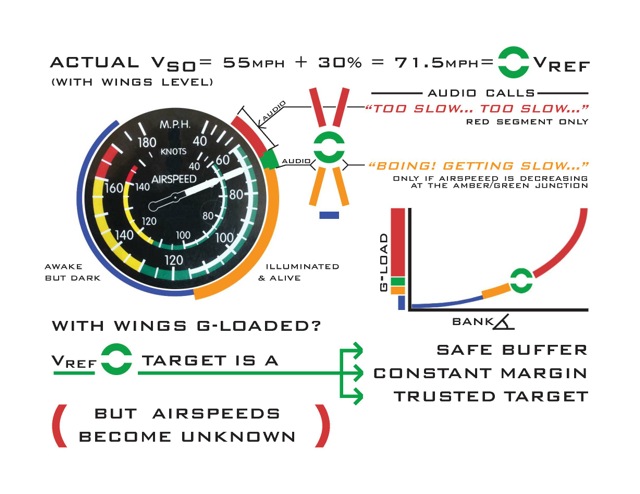
"Now all this may be just fine if we shift out the pattern to fly a wider ground track, but in the case where (by habit, perhaps? sloppiness?) we fly the downwind leg with a close-in offset from the runway, we set up a possible overshoot, especially during the turn to Final. Any extra speed -- extra energy -- results in a much wider-than-normal turn radius.
"Then an unhealthy human tendency to “get there” by banking a "just a bit more"and loading the wing by pulling up-elevator -- to avoid getting low -- results in overly steep banks and a wing-loaded accelerated stall at an unrecoverable low level.
"But suppose the pilot were more precisely aware of how close s/he was to an incipient stall? An Angle of Attack (AOA) display can tell us exactly how much margin above stall remains. Then, having that assurance and comfort level, we can FLY SAFELY SLOWER and the turn radius decreases significantly. The wing loading remains very low --- a far more correct technique, and especially so when down near the dirt.
"Two displays can help with that: the Mechanical AOA display is very simple and entirely mute. While it is true that one must be looking at it to reap any benefit, it's a great visual device; it helps us "see the air". The Enhanced Legacy AOA Display is aerodymanically similar, yet much more capable; and it talks to us--much as, in a crew, the Pilot Not Flying might--even if we are distracted or looking out the window. Nice.
"As you read on, don't forget that an AOA Display will not improve any aircraft's performance, not even a little bit! But an AOA will provide sufficient additional information to give the pilot confidence to operate safely closer to the airplane’s limits.
"Why should you listen to me? I am not a CFI, not an aeronautical engineer, nor am I a teacher. I offer you only my experience ... from Alaska's Prudhoe Bay, over much of Canada, north to 2,500-3,000 ft. gravel runways on Baffin Island, over to Greenland, and to the far southeast Caribbean, to Mustique's tiny runway in a valley, very short. In fact, ANY manuvering flight regime becomes much more comfortable, and especially so as a pilot approaches the margins of the aircraft's flight envelope in Steep Banks or in Slow Flight. If one knows AOA, and is AOA-equipped, then these places and manuevers are easy...and safer."
JACK STOVALL'S STORY:
"I hate driving down the freeway, in heavy traffic, when some lousy driver will simultaneously turn on a blinker and immediately cut in front of me. I have to slam on the brakes and worry about getting hit from behind.
"When I started flying, I would always use my vertical speed indicator to maintain level flight because it's the most accurate altitude trend gauge in the cockpit. (I know, I know...it has some problems with lag and the altimeter should always be used. But I still use my IVSI as early warning of an altitude deviation; then I look back at the altimeter.)
"So....what do the two above statements have to do with anything? I'll try to clarify what came to mind when I first saw and used the Enhanced Legacy AOA display. I had never seen that AOA system prior to that day.
"Almost every certified airplane in the United States has an AOA indicator already. It's called the stall warning and it works just fine. It doesn't need an airspeed indicator to work at all. The problem is that it's just like the inconsiderate driver who cuts us off in traffic. We get the warning ... but it's almost too late to do anything about it. (Here, I'm talking about when it comes on unexpectedly, not when we are out doing stall practice).
"The AOA behaves more like the thoughtful driver who signals his intentions well before the lane change and gives us time to adjust our behavior to help avoid a collision.
“Another thing: AOA helps calibrate the airspeed indicator for the approach to be flown. I was new to Fred’s cockpit, yet when I got the “Donut”, I looked back to the airspeed indicator and flew that particular airspeed to maintain the Donut. The AOA doesn't care what the airspeed indicator says. If the AOA has been calibrated properly, it'll tell us the proper airspeed to fly Final. We use the AOA to find the correct airspeed target, and then use the airspeed indicator to fly the approach because the airspeed indicator is our best, most accurate, trend monitor .
"And now, let's talk about another feature. The Enhanced AlphaSystemsAOA calls out a clear early warning: ("Enhanced" means it includes an Aural Early Warning of "Getting Slow" or the "Deedle-Deedle" tone) when we exceed a certain angle of attack. Just think how nice it would be to have such a gentle warning when our speed decays below, let's say: 80 kts on approach in my Baron.
"So, is an AOA necessary? ...is it nice to have? The answer to the first part of the question is easy: No.
"Nice to have?
Yes, indeed!"
THE PROJECT BEGINS...
Tom Rosen continues..."To honor our four friends lost in these two crashes, two of us (Tom and Fred) began an effort to learn more, and  to discover what AOA devices were available. We brought in other experts to help us...all were volunteers. The four authors here have been involved almost the entire time; we four have each been flying, mostly Beechcraft, for almost 50 years, each of us using aircraft -- most of which were equipped with Angle of Attack Indicators (AOA) -- in somewhat different ways. to discover what AOA devices were available. We brought in other experts to help us...all were volunteers. The four authors here have been involved almost the entire time; we four have each been flying, mostly Beechcraft, for almost 50 years, each of us using aircraft -- most of which were equipped with Angle of Attack Indicators (AOA) -- in somewhat different ways.
"We decided that we would need (Step A) to prove the devices using professional flight test procedures, and only then (Step B) promote any and all devices that provided useful information to a pilot. As soon as the early test flights began to show real promise, I installed an AOA system in my own S-35 Bonanza, and, with tips from a few experts, taught myself to fly it. Fred installed an AOA display in his King Air, too (this image is the current-model "EAGLE AOA") . We undertook this project at our own expense. Ultimately we purchased and gave away a number of---by then well-proven---AOA displays to flight academies and asked each to evaluate the AOA. We asked that they try to determine best practices in training their students.
"In these efforts, we were helped immensely by many expert aviators and not one person or company would accept any compensation for their time, fuel costs, or their expertise."
This flight data research and educational effort was initiated and funded by friends of skilled aviators gone west.
All the research and reports have been placed in the public domain
IN HONOR OF
David Ingalls Brown and Robert H. Baldwin
TWA Captain Ray Rotge and TWA Captain Mack Johnston |
HOW AOA REALLY SHINES
BANKING: The steeper the bank, the more the wing is G-loaded, and the more the AOA adds value. As bank increases, we receive decreasing value from the ASI, which has an increasing potential to mislead us. For tight radius turns, we can slow to the Donut, note the IAS, and then fly Attitude and Airspeed, comfortably and securely well above stall speed.
ADDED LATER: we are aware that Angle of Bank has nothing to do with AOA directly. What is implied in the widely-used but too-simplistic graph ("Stall speed vs. Angle of Bank") is that the aircraft is being held in level, non-descending flight, and thus we are commanding greater and greater G-loading and driving the AOA higher. The bank itself has nothing to do with the stall. A wing stalls at a given AOA, period. An airfoil can be driven to stall at any speed, any pitch, any bank.
ENERGY MANAGEMENT: On a recent IMC approach to WX that was ~400-2, the normal speeds were flown BUT the pilot was planning to be precisely On Speed (Donut. OAA. 1.3Vso) at Short Final because of a relatively short runway. When the runway came into sight at minimums, he reduced power (to his remembered setting) and the aircraft immediately slowed to the Donut (1.3Vso) in his peripheral vision. The color change to a FULL Donut is very obvious if the AOA is mounted correctly: on or just beneath the glareshield, within peripheral vision. The turnoff was at the mid-field taxiway. This is so easy when we are so confident that we are On Speed (regardless of weight, remember?).
EARLY VERBAL WARNINGS: Any pilot can be distracted. But when we hear a synthesized voice quietly announce "Getting Slow" (at ~1.4Vs); it is much like a helpful Pilot Not Flying (copilot). Fred hears the alert occasionally at the top of a long climb in his King Air and we all hear it on every approach. He has taught himself to respond by "Agree. Thanks." and then lower the nose by a degree or "Agree. Perfect.". That may sound ridiculous as you read here, but it comforts the passengers. and it's exactly what we'd say to a professional pilot in our right seat.
|
In the ABS News December 2015 issue, we address
HOW WE FLY WITH AN AOA
Any AOA display should be mounted up high---ideally: just above the glareshield and in the periphery of a pilot's line of sight vision as he looks at a runway ahead.
The AlphaSystemsAOA is installed, then flown to actual/near stall, and is then electronically calibrated to ~1.3 times that stall Airspeed...whatever it happens to be on that indicator in that aircraft. There's more to it, but that's what we mean by "setup".
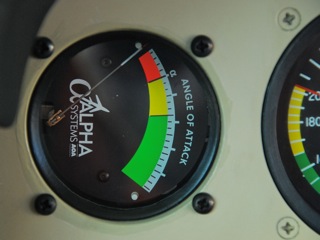
SETTING UP the MECHANICAL DISPLAY. If you choose to install a mechanical panel-mounted AOA, we suggest that you mount and calibrate it like a ABS member (a US Naval Aviator) has done here in his Bonanza so that the Greek Alpha (the "α" at the Red/Yellow transition) is set at a considerable margin prior to stall (~1.2Vso to ~1.3Vs.). THAT Optimum Angle of Attack (OAA) gives you a repeatable known margin, a repeatable known buffer, and at THAT Alpha point...you will not stall.
Needle high? Push it down, or relax a bit of back pressure
Needle low? Pull it up.
So that means your very Short Final segment ("over the fence") will be flown just slightly into the red zone above OAA, with a smaller stall margin. That's surely exactly the way you "fly short" now. Could you adjust the OAA, later on ... as you get to know the device? (Perhaps even set very close to stall, for a very specific purpose, such as in very tight bush pilot operations?). Of course. But whatever target you choose, be sure to placard the setting, so the next pilot will know to what Alpha it's calibrated, in relation to stall.
SETTING UP the AlphaSystems ENHANCED LEGACY DISPLAY ("Enhanced" means it includes an Aural Early Warning by "Slow Sarah" or the "Deedle-Deedle" tone) . This is a more sophisticated device, designed for early stall warning as well as precision slow flight.
Basically, the AOA display can be thought of as a real-time Vref calculator.
Huh? Vref? What's that? Pilot lingo often includes: "Bug Speed" "Reference Speed" "Final Approach Speed" or "Target Speed", but in this article we'll use "Reference Speed" or "Vref".
Vref is the green Donut (it's blue in later models) seen here. 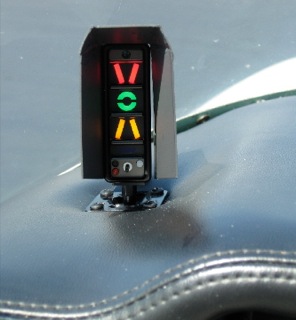 The display is arranged fairly intuitively - a bifurcated Donut in the middle ("ON SPEED; at Vref"), an amber chevron on the bottom ("You're OK, just a bit faster than Vref") and a red chevron on the top ("Danger Zone"). [Here, the display is in Self-Test and all segments are illuminated. In flight, we'd see only one or two segments.] The display is arranged fairly intuitively - a bifurcated Donut in the middle ("ON SPEED; at Vref"), an amber chevron on the bottom ("You're OK, just a bit faster than Vref") and a red chevron on the top ("Danger Zone"). [Here, the display is in Self-Test and all segments are illuminated. In flight, we'd see only one or two segments.]
The "Enhanced" (meaning: "tones or voice alerting") Legacy AOA can help us when we are not even looking at it. It can alert our distracted brains with an aural "Getting Slow" and if that alert should occur at about 40% above stall, that's good enough. Later, when much closer to stall, we'll hear a lady's calm voice "Too Slow"..."Too Slow"..."Too Slow"
We suggest that you calibrate the AOA to your Reference Speed-- Vref --so that
the Donut will be displayed at a considerable margin above stall (~1.2Vso to ~1.3Vs.). THAT Optimum Angle of Attack (OAA) gives you a repeatable known margin above stall, and at THAT Alpha point...you will not stall. It also makes the Donut into a really good Vref target for manevering at your slower speeds.
HOW DO WE ACTUALLY USE THE AOA?
FRED SCOTT: How I Fly the AOA
"Because I use the AOA display as a real-time Vref calculator, I have no need to open the POH and to dig into the performance section to calculate Vref; there is no need to calculate abnormal G-loads due to steep banks, etc. No pilot can do that complex math in real time. Regardless of weight, temperature, density altitude, or wing loading, the AOA indicator displays Vref instantaneously and continues to provide accurate information throughout the flight, and on successive flights.
"An AOA is especially useful in a steeply-banked turn, or when I need to fly a tight radius circle, or during a short field landing. Here's what tbe G-Load vs Bank graph and AOA look like in a steep bank. Compare with the similar graph above and note that the ASI-Alpha relationship is quite different when a wing 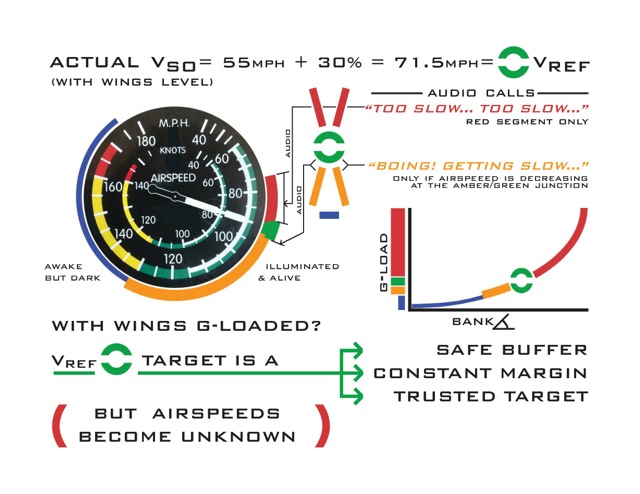 is G-Loaded: is G-Loaded:
"When banking, I'll glance at the AOA display, quickly crosschecking the ASI and noting my Airspeed fast/slow vs. the Vref Optimum Alpha. If necessary, I'll make a correcting pitch input so as to re-center the Donut on the target OAA, and then scan back to use the primary instrument--the ASI--(while staying at that same bank angle) to retain the "sure thing", the assurance...to confirm that the margin above stall remains available
"So: the ASI is always the primary instrument; the AOA is the Vref calculator. Does that logic appeal ?
"But, if I change the bank? I'd just re-check the AOA, and re-set my mental AirSPEED target ... AirSPEED is the certificated primary indicator; AOA is very good info, but only advisory. That's important. The FAA states the same points in their excellent .
"Simple enough. Cross-check AOA with Airspeed being the primary reference. Works for me. Finally...if the pilot gets distracted and fails to cross check AOA, "Slow Sarah" quietly announces [click to hear her] "Getting Slow". Hard to ignore, isn't she? That is the value of the enhanced AOA. "
LET'S HEAR FROM AL AITKEN
Our Marine test pilot, LtCol (Retired) Al Aitken has much more experience testing/teaching AOA than Tom or Fred. Al designed the test flight plan; he and Fred flew the AOA test flights together. Al now flies a Beechcraft Bonanza which has the same AlphaSystemsAOA installed. Why? ... because immediately after he helped test fly and prove the device, he became convinced of its value, so Al installed that AOA. Call sign "Easy Al" Aitken has a degree in Aeronautical Engineering, is a graduate of the NAS Patuxent River Test Pilot School, and was the Senior Fixed-Wing Test Pilot Instructor at PAX River. He flew initial tests in the F/A 18 Hornet for the Corps. A Falco builder too, Al has also first-flight tested many of the home-built Falco aicraft that have won so many Oshkosh awards. After a full career in the Corps, he flew for American Airlines. Al Aitken sees civilian AOA usage in light aircraft pretty much the way we do and explains in slightly different words:
AL AITKEN: How I Fly the AOA
"I recommend that all AOA Indicator users "mentally calibrate” their AOA systems similar to John Eckalbar’s recommended and widely-accepted Flying By The Numbers, just as our BPPP CFIs suggest. In other words, calibrate the aircraft's AOA system--as the FAA also suggests--to display the Donut at 1.3Vso [Or...see indented text ff.] and then go on to "mentally calibrate" (memorize) the AOA system for the other phases of flight such as Vx and Vy (clean and dirty), cruise climb, the various terminal operations phases such as flying the approach with Approach Flaps and 120 KIAS (as I did), and so on. I say "mentally calibrate", because most simple AOA systems will have only one indication as the target AOA such as our Donut for 1.3 Vs or Vso. Other indications for other phases would then require a mental recall...such as (offered here only as a example): the amber chevron and bottom half of the Donut combo might indicate Vy in the clean configuration.
OR...calibrate the donut at 1.3Vs since on most light GA aircraft the flaps make little AOA difference at Vs. Don't believe it? In the print editions, the ABS editors asked us to omit graphs and equations, but herein we include one that is important to understand the relationship of Lift to AOA. From the classic "Aerodynamics for Naval Aviators", this graph--with flaps deployed 30 deg.--depicts Lift (CL) as a function of AOA for various flap designs with flaps up and with flaps down. This graph shows a basic wing section and design variations: with plain, slotted, split and Fowler flaps. In all but the Fowler, the peak CL (stall) shifts almost straight upward (a very small AOA shift) when flaps are deployed...with little discernible difference in AOA. This graph in the“Aerodynamics for Naval Aviators” is not “laboratory precision” quality, but rat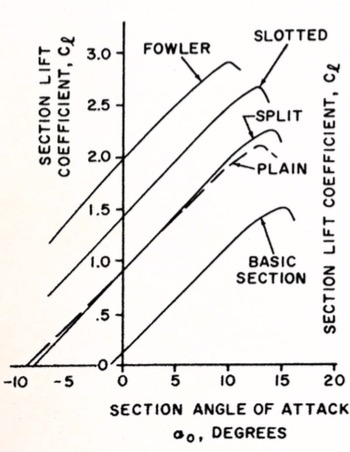 her simply tells a story. her simply tells a story.
Fowler flaps are different in that they do exhibit a shift in AOA as the peak CL moves upward. BUT: Very few light GA aircraft have Fowler flaps.
The most AOA shift for the three non-Fowler designs occurs with the slotted flap, and even then it is only a ~2 deg. AOA shift...which is only a ~13% shift within the available 15 deg. AOA range.
There certainly is a difference in airspeed at peak CL (stall) with flaps up vs. down, but not much difference in terms of AOA--as the graph shows--and that's exactly what we verified in flight test. That's why we include here the graph...to explain what we were seeing.
The important point though, is not the shift in AOA, but rather the consistent, reliable, early, and continuous warning that our tested AOA system gave us..
We tested Vso at a given gross weight and calibrated the green donut for 1.3 times that airspeed. When we tested Vs at that same gross weight, we found the green donut to come on at about that same 1.3Vs. Puzzled, we wondered why it appeared to make little or no difference in AOA indication with flaps up or flaps down. The graph here helped us understand that there was no need for flap bias in the system, because the effect of flaps on AOA--for a typical GA non-Fowler flap design--was minimal.
"Many Beechcraft pilots already use a “flying by the numbers” routine to memorize acceptable speed, configuration, and power combinations that make it easy for them to fly various phases without “chasing” the throttle and airspeed all the way down the glideslope. Once they have mentally noted an acceptable combination and learned and memorized it, any phase of flight is a piece of cake. The same can now be true of the AOA Indicator...except that the AOA Indicator is better, because it automatically adjusts for weight changes as fuel is burned off. This AOA device works very well, exactly as it was designed to do. It is an inexpensive product that does not have the high precision that our very expensive military or transport aircraft AOA devices offer.
"No matter. These AOA devices are “Good Enough” to help us a lot, especially so in speed (Alpha) precision and early warning of stall. One caveat is that our AOA indicator has a speed range of about seven knots with the full donut lit. Although mine was calibrated at 1.3Vso of 71 KIAS at a given airplane weight, I found I could fly the full donut across a range of about 72 KIAS to 66 KIAS. Other pilots’ test flights have determined that similar ranges exist for a slow chevron, fast chevron, etc.
"My point is that high cost laboratory precision in instrumentation is not required to extract very useful information and good performance from our light aircraft.
"After a long career as a Marine aviator and later as  a civilian, I have learned to keep things very simple in my cockpit. I like to use the AOA indication in the most simple way as well. I fly the Donut at 1.3Vso and fly other phases of flight using my memorized AOA indications. When I flew my Bonanza at 1.3Vso on short final, using power to control glideslope, I found the flare to be easy, short-lived...and it was satisfying to hear “Slow Sarah” say “Too slow” just as the tires touched. Perfect! All of this I might add…just before the aircraft stall warning horn sounded. Rollouts were always short and with minimal braking. a civilian, I have learned to keep things very simple in my cockpit. I like to use the AOA indication in the most simple way as well. I fly the Donut at 1.3Vso and fly other phases of flight using my memorized AOA indications. When I flew my Bonanza at 1.3Vso on short final, using power to control glideslope, I found the flare to be easy, short-lived...and it was satisfying to hear “Slow Sarah” say “Too slow” just as the tires touched. Perfect! All of this I might add…just before the aircraft stall warning horn sounded. Rollouts were always short and with minimal braking.
"An AOA will enable a pilot to extract all--or, at least: far more of--the airplane's available performance. An AOA can definitely make a good pilot better and enable him to fly more precisely."
JACK STOVALL; How I Fly the AOA
"I related my AOA technique in the November 2015 issue (on this webpage, near the top). Let me repeat only the highlights...
"Almost every certified airplane in the United States has an AOA indicator already. It's called the stall warning and it works just fine. The problem is that we get the warning ... but it's almost too late to do anything about it. (I'm talking about when it comes on unexpectedly).
The AOA alerts us well before we have a problem and gives us time to adjust our behavior.
“AOA also helps calibrate the airspeed indicator for the approach. I was new to Fred’s cockpit, yet when I got the “Donut”, I looked back to the airspeed indicator and flew that particular airspeed to maintain the Donut. The AOA doesn't care what the airspeed indicator says. If the AOA has been calibrated properly, it'll tell us the proper airspeed to fly Final. We use the AOA to find the correct airspeed target, and then use the airspeed indicator to fly the approach because the airspeed indicator is our best, most accurate, trend monitor .
"And now, let's talk about another feature. The AlphaSystemsAOA calls out a clear verbal warning: 'Getting Slow'. [click to hear her] when we exceed a certain angle of attack. Just think how nice it would be to have such a gentle warning when our speed decays below, let's say: 80 kts on approach in my Baron.
"So, is an AOA necessary? ...is it nice to have? The answer to the first part of the question is easy: No.
"Nice to have?
Yes, indeed!"
TOM ROSEN: How I Fly the AOA
"Do you calculate the stalling speed for the weight of the airplane before each flight? Do you then calculate 1.3 times Vso for the landing target speed before each flight? And taking it one step further, would you do it before descent after burning off 100 gallons of fuel during a long cross country?
"The reason I'm asking is because I am guilty of not doing it. Instead, I used "ballpark" numbers plus a bit more speed for almost all of my approaches. I guess most light aircraft pilots do the same—they ballpark their landing speeds and fly too fast, like Fred suggested in the November article. That’s what I did, of course, before installing my AOA.
"We never did that in the airlines. Vref was calculated before every landing, and airspeed indicator bugs were set in the ASI for each flap configuration. I've never done that in my Bonanzas because there was no airspeed bug (maybe that's just an excuse).
"The AOA allows precision control on every landing. More importantly, it shows the pilot the correct target and where the airplane is in regards to that target. That's the new concept of AOA flying in my book. It’s why it's such a better way of flying to teach beginning students from the get-go."
COMMON-SENSE REGULATORS SPEAK UP
MAKING PROGRESS in the GA Fleet!
"When we began our journey of discovery and then expanded our AOA investigation, there were only a few hundred AOAs installed in light aircraft.
"In early 2014, the Secretary of Transportation and the FAA Administrator held a joint news conference to make the unprecedented announcement, (paraphasing here):
"...if the FAA were to require certification of these simple AOA indicators, they would cost too much and pilots would not buy them in quantity...so A&Ps should just go ahead and install these uncertified sensor/displays as minor alterations...because they work pretty well, because they will save lives."
"We were deeply moved when we heard that news. After being involved in aviation for the vast majority of our lives, it is so joyful and stimulating still to be learning better ways to fly--and with some measure of success appearing on the near horizon. We are familiar with federal bureaucracy and this announcement is the tip of an iceberg that suggests a deep bench of common-sense decsion-makers on the FAA engineering teams. Courageous leadership comes also to mind.
The FAA followed up in April 2015 with an AOA Addendum to the Instrument Flying Handbook. Short and to the point, it should be truly valuable to any pilot ...and...
...in October 2015, they updated the FAA Currency Requirements and Guidance for the Flight Review and Instrument Proficiency Checkguide with a new emphasis on AOA (see page 16, Paragraph 4-3d) How To Review AoA during IPC flights.
By mid-summer 2015, the count increased to about 2500-3000 AOAs installed with several manufacturers offering useful products.
"Bendix-King 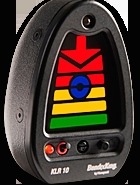 offered this KLR10 AOA. It was made for BK by Alpha Systems and is substantially similar to the Enhanced Legacy that we flight tested. In 2018, I don't believe it's offered anymore offered this KLR10 AOA. It was made for BK by Alpha Systems and is substantially similar to the Enhanced Legacy that we flight tested. In 2018, I don't believe it's offered anymore
Several other manufacturers sell similar s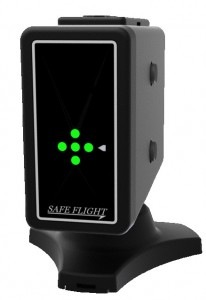 ystems. ystems.
Significantly, Safe Flight Instrument Co. which makes most of our light aircraft leading edge stall warning vanes, now offers its own , seen here.
THANK YOU ALL!!!
We offer here our sincerest thanks--to dozens of CFIs and DPEs, to former and active military pilots, to the FAA Small Aircraft Directorate engineers, to several FAA Flight Check and Flight Test pilots, to aviation writers, and to AOA manufacturers (several of which have modified products at our suggestion)--all of whom have helped us along this journey. NOT ONE ever asked for a nickel of financial help for their hours of time and gallons of fuel they invested in re-proving that our test flight reports were replicable and our conclusions valid. Not one person.
Greatly experienced and highly skilled, they all understood that "This needs doing".
Tom Rosen (ABS 2669 ) is a retired TWA Captain, a former ABS board member. He flies a Bonanza
Al Aitken (ABS 47604 ), US Marine call sign "Easy Al", has a degree in Aeronautical Engineering, is a graduate of the NAS Patuxent River Test Pilot School, and was the Senior Fixed-Wing Test Pilot Instructor at PAX River. He flew initial tests in the F/A 18 Hornet for the Corps. A Falco builder too, Al has also first-flight tested many of the home-built Falco aicraft that have won so many Oshkosh awards. After a full career in the Corps, he flew for American Airlines.
Jack Stovall (ABS member) retired from Delta as a senior Captain. Prior to flying for Delta, Jack was an Air Force flight instructor at the USAF T-38 Pilot Instructor Training (PIT) school and ended his career as a Instructor Pilot of other Instructor Pilots. Jack has logged thousands of hours looking at an AOA, and thousands of hours TEACHING AOA,
Fred Scott (ABS LIFE 2219) is a ~6,000 hour Commercial, Instrument, Float Plane pilot, typed in the Cessna CJ-1 (with an AOA display), and currently flies his King Air 90 Blackhawk (with the "Eagle" AlphaSystemsAOA). Fred learned to fly near his New River NC Marine Corps base at a small grass strip; early on, he was privileged to hangar-chat with dozens of active duty Marine pilots to whom AOA was perfectly normal, so he assimilated a bit of their AOA know-how long ago. For ~30 of his ~50 years as a pilot, he has flown light aircraft equipped with simple AOA displays.
Neither Tom Rosen, nor Al Aitken, nor Jack Stovall, nor Fred Scott, nor anyone who helped them with this research (each one helping entirely at their own expense) has ANY financial interest, now or ever, in ANY Angle of Attack manfacturer or in ANY AOA product line. The information provided in this article is provided free of charge by its authors and ABS. All information is provided 'AS IS'. No guarantee is provided for the accuracy of the information or the application of the information provided herein. This information is provided entirely in the spirit of helpful cooperation.
Do you want more info? Here is a LIST OF ALL THE AOA MANUFACTURERS that I'm aware of.
Here's a summary of regulatory guidance clearly indicating that installation of an independent secondary advisory AOA like the "Legacy" is a "minor alteration" on the vast majority of light general aviation aircraft.
ADDENDUM Dec 30, 2015: AlphaSystemsAOA latest software update:
The latest software from AlphaSystemsAoA allows the use of an Input/Output Module which can be configured to sense up to three different Flap Positions. There are several ways to handshake the sensors to the OEM equipment and the two must be "isolated"—using fuses, blocking diodes, relays and the like—to remain a Minor Alteration. The FAA's Chicago ACO has been very helpful and encouraging in that line.
.
One calibrates the newer software just like the earlier versions: at Ground, then airborne at 1.3Vs and at Va. There is a new—a fourth—set point of 1.0 Vs (stall) if the owner desires that precision. This has been in the works since Dr. Dave Rogers made his suggestions to Mark Korin at Sun N Fun 2015
Thereafter, and—if the I/O box is installed—the aircraft is flown dirty at a given flap setting, then the AoA is calibrated at 1.3 times that number. Same process repeats for up to two other flap deployments, and at the owners discretion.
There is one Mitsubishi MU2 flying with this AoA system with multiple kits ready for aircraft upgrade by the parent company.
There are 15-20 Malibu/Mirage/Meridian types flying. The owners have support from the MMOPA which helped develop and refine the flap-capable system.
There is one TBM 850 flying with this latest version.
All this stuff has been available for sale at AlphaSystemsAoA for some time. I haven't flown it.
These simple AoA systems all seem to be designed to function well—if not perfectly—in the lower speed ranges, below Va mostly. That's where the problems are; that's where we are dying in maneuvering flight. None that I'm aware of are designed to present AOA for "the full operating envelope of the aircraft".
They are "stall warning" devices, really; they do give us EARLY WARNING of stall, very AoA-like, and very closely so. Exactly as they are designed to do. A big improvement over a few years ago.
Consider: "The OEM Stall Vane has a limited range and is therefore ineffective." The first part is true, the latter is not. Of course it does. It is designed ONLY to alert us very near to stall, and in that range, it works well. The uncertified AoAs are great improvements to our OEM Stall Vanes. These AoAs are designed ONLY to alert us quite a bit sooner, and they have secondary benefits, as well. Improvement!
I'm sure that manufacturers are reading and studying I agree that they should, and maybe more progress will follow. I hope so. A few of them have already modified...improving...their systems based on his good work. Terrific.
But if these things become too fancy, too perfect, then so will the cost. At that point, owners will stop installing them. The Secretary of Transportation and the FAA Administrator said exactly that in January 2014.
We will soon see aircraft manufacturers installing these imperfect AoAs in new aircraft, based on the encouragement by the Secretary of Transportation and the FAA Administrator. I greatly admire these men (and their engineer advisors) for such a common-sense recommendation |






